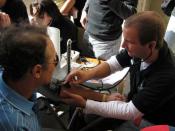Question 1
The young female should be instructed make sure she is being carful when using the toilet and engaging in sexual intercourse. This is because improper toilet habits (wiping back to front after defecation) can easily carry fecal bacteria into the urethra. Also most urinary tract infections occur in sexually active women, because intercourse drives bacteria from the vagina and external genital region toward the bladder. The use of spermicides' magnifies this problem, because the spermicides kills helpful bacteria, allowing infectious fecal bacteria to colonize the vagina. Symptoms of urinary tract infections include dysuria, urinary urgency and frequency, fever, and sometimes cloudy or blood-tinged urine. When the kidney's are involved, back pain and a server headache often occur. The young women needs to know the signs of each infection to prevent a kidney infection from occurring. At the time being, antibiotics would be prescribed to cure her urinary infection.
Text page 879
Question 2
Question 3
Factors which allow urine to become more concentrated are the intrinsic and extrinsic controls which regular renal blood flow. By adjusting its own resistance to blood flow, a process called renal autoregulation, the kidney can maintain a nearly constant GFR despite fluctuations in systemic arterial blood pressure. Renal autoregulation entails two types of controls: a myogenic mechanism and a tubuloglomerular feedback mechanism. The myogenic mechanism reflects the tendency of vascular smooth muscle to contract when stretched. Increasing the systemic blood pressure causes the afferent arterioles to constrict, which restricts blood flow into the glomerulus and prevents glomerular blood pressure from rising to damaging levels. Declining systemic blood pressure causes dilation of afferent arterioles and raises glomerular hydrostatic pressure. Both responses help maintain a normal GFR. Autoregulation by the flow-department tubuloglomerular feedback mechanism is "directed" by the macula densa cells of the juxtaglomerular...


